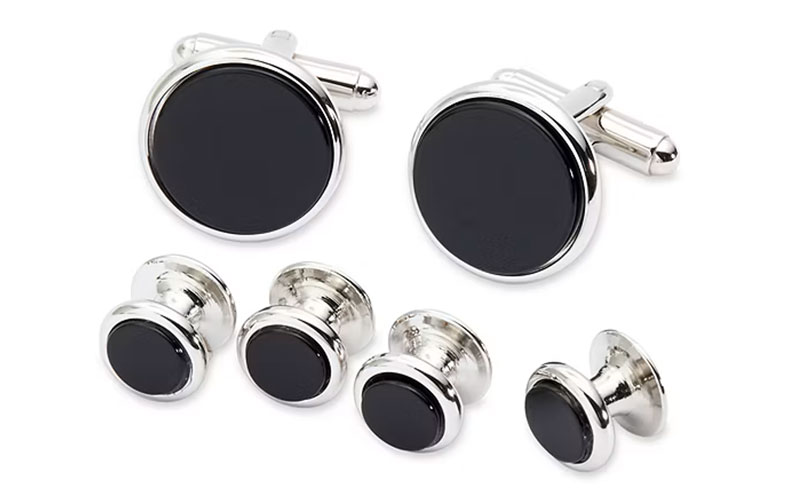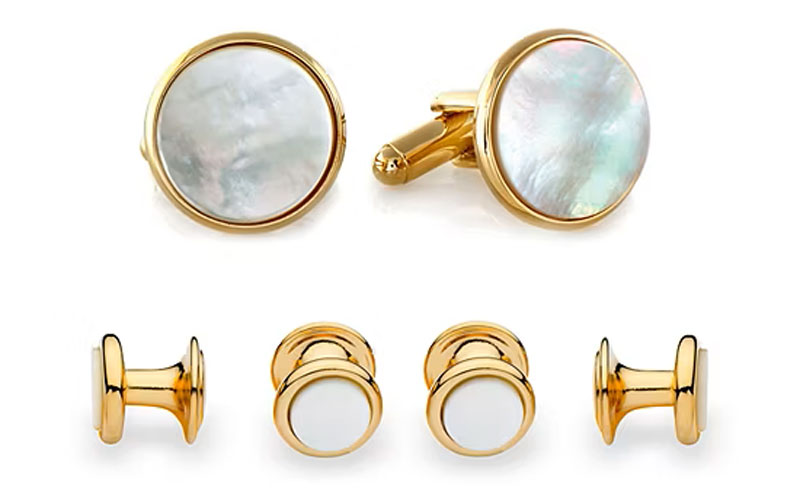As a delicate clothing accessory, cufflinks not only have practical functions, but also symbolize the wearer’s taste and identity. Therefore, the cufflink market has always attracted much attention, especially in business and formal occasions. Here, Yuheng will introduce the factors affecting the wholesale cufflinks price in depth, and conduct a detailed analysis of the market to help merchants and consumers better understand this field.

1. Raw Material Cost
The raw material cost of cufflinks is the primary factor determining the wholesale price. Common cufflink materials include stainless steel, brass, silver, gold, platinum, and various gemstones and pearls. The prices of different materials vary greatly. For example, the cost of stainless steel and brass is relatively low and suitable for large-scale production; while gold, silver, platinum, and gemstone-inlaid cufflinks are expensive and mainly target the high-end market.
Not only that, market fluctuations in raw materials will also directly affect wholesale prices. For example, fluctuations in the prices of gold and silver often lead to instability in the prices of cufflinks of corresponding materials. Understanding the market situation of raw materials and adjusting the purchasing strategy in a timely manner can effectively control costs and enhance competitiveness.
2. Production Process
The complexity of the production process directly affects the cost of cufflinks. Simple mechanical stamping is suitable for mass production and has relatively low costs; while complex hand-carving, inlaying and other processes require more manpower and time investment, resulting in rising costs. In addition, the degree of sophistication of production equipment and the degree of optimization of process flow will also affect the cost. Although high-tech equipment has a large initial investment, it can improve production efficiency and reduce unit costs.

3. Design and Brand
The design and brand of cufflinks are important factors affecting the wholesale price. Unique design, exquisite shape and high-end brand often give cufflinks higher added value. Even if the materials and processes of some well-known brands of cufflinks are similar, the wholesale price is often much higher than that of ordinary brands due to brand premium. This brand effect comes from the recognition and trust of the brand in the minds of consumers. For emerging brands, creating a unique design and establishing a good brand image are important means to increase the added value of products.
4. Market Demand and Supply
The market supply and demand relationship is one of the key factors that determine the wholesale price of cufflinks. When demand is strong and supply is insufficient, the wholesale price will rise; conversely, when supply exceeds demand, the wholesale price will fall. Seasonal demand changes are also an important part of market supply and demand. For example, wedding season and holidays are usually the peak sales period for cufflinks, with a surge in market demand and a corresponding increase in wholesale prices.
In addition, the launch of new styles in the market, clearance sales of old styles, and pricing strategies of competitors will have an impact on market supply and demand, thereby affecting wholesale prices.

5. Sales Channels and Logistics
Sales channels and logistics costs are also important factors affecting wholesale prices. Traditional wholesale channels include distributors, agents, and retailers, and the price increases will raise the terminal price. In recent years, the development of e-commerce platforms has provided new channels for cufflink sales, reducing intermediaries, reducing costs, and the wholesale price is relatively low.
Logistics costs include transportation, warehousing, and distribution. For international trade, tariffs and international freight are important cost components. Choosing an efficient logistics solution and optimizing inventory management can reduce logistics costs and improve price competitiveness.
6. Market Analysis and Prospects
At present, the global cufflink market shows a trend of diversification and personalization. Consumers are no longer satisfied with a single functional demand, but pay more attention to the decorativeness and personalized expression of cufflinks. With the improvement of consumption levels, the market prospects for high-end customized cufflinks are broad. Especially in emerging markets such as China and India, with the rise of the middle class and the upgrading of consumption concepts, the cufflink market has great potential.
From the perspective of market competition, traditional brands still occupy the main market share, but emerging brands continue to emerge and rise rapidly with their unique design and precise market positioning. The development of e-commerce provides a broad market space for emerging brands and lowers the entry threshold.
In the future, the cufflink market will pay more attention to environmental protection and sustainable development. The enhancement of consumers’ environmental awareness has prompted companies to pay more attention to environmental protection and sustainability in selecting raw materials and production processes. The use of recyclable materials and the reduction of pollution and waste in the production process will become important directions for the industry’s development.

7. Practical Suggestions
- Control costs: Rationally select raw materials, optimize production processes, and reduce production costs. Pay close attention to raw materials’ market conditions and flexibly adjust procurement strategies.
- Innovative design: Strengthen design research and development and launch new styles that meet market demand. Pay attention to consumers’ personalized needs and provide customized services.
- Brand building: Establish brand image, enhance brand awareness and reputation. Expand market influence through multi-channel promotion.
- Optimize channels: Expand e-commerce channels, reduce intermediate links, and reduce sales costs. Choose an efficient logistics solution and optimize inventory management.
- Pay attention to environmental protection: actively practice environmental protection concepts, use sustainable materials, optimize production processes, and reduce environmental pollution.
The cufflinks wholesale price is affected by many factors, including raw material costs, production processes, design and brand, market demand and supply, sales channels and logistics. By deeply understanding these factors and combining market analysis, companies can formulate scientific pricing strategies to enhance market competitiveness. In the future, the cufflink market will continue to develop in the direction of personalization, diversification and environmental protection. Companies should seize opportunities, innovate and develop, and achieve sustainable growth. Want to get more about the price of cufflinks? Click for details!
